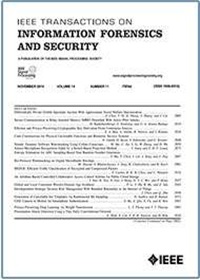Boosting Accuracy of Differentially Private Continuous Data Release for Federated Learning
IF 6.3
1区 计算机科学
Q1 COMPUTER SCIENCE, THEORY & METHODS
IEEE Transactions on Information Forensics and Security
Pub Date : 2024-10-09
DOI:10.1109/TIFS.2024.3477325
引用次数: 0
Abstract
Incorporating differentially private continuous data release (DPCR) into private federated learning (FL) has recently emerged as a powerful technique for enhancing accuracy. Designing an effective DPCR model is the key to improving accuracy. Still, the state-of-the-art DPCR models hinder the potential for accuracy improvement due to insufficient privacy budget allocation and the design only for specific iteration numbers. To boost accuracy further, we develop an augmented BIT-based continuous data release (AuBCR) model, leading to demonstrable accuracy enhancements. By employing a dual-release strategy, AuBCR gains the potential to further improve accuracy, while confronting the challenge of consistent release and doubly-nested complex privacy budget allocation problem. Against this, we design an efficient optimal consistent estimation algorithm with only为联合学习提高差异化私有连续数据发布的准确性
将差异化私有连续数据发布(DPCR)纳入私有联合学习(FL)是最近出现的一种提高准确性的强大技术。设计有效的 DPCR 模型是提高准确率的关键。然而,最先进的 DPCR 模型由于隐私预算分配不足以及仅针对特定迭代次数进行设计,阻碍了提高准确率的潜力。为了进一步提高准确性,我们开发了基于 BIT 的增强型连续数据释放(AuBCR)模型,从而显著提高了准确性。通过采用双重发布策略,AuBCR 有可能进一步提高准确性,同时还能应对一致发布和双重嵌套复杂隐私预算分配问题的挑战。为此,我们设计了一种高效的最优一致估计算法,每次释放的复杂度仅为 $O(1)$。随后,我们引入了 $(k, N)$ -AuBCR 模型概念,并设计了一种元因子方法。这一创新将优化变量从$O(T)$大幅减少到$O({{lg^{2} T}}\right)$,从而大大提高了最优隐私预算分配的可解性,并同时支持任意迭代次数T。我们在经典数据集上的实验表明,与传统的私有FL相比,AuBCR的准确率提高了4.9% ~ 18.1%,与最先进的ABCRG模型相比,提高了0.4% ~ 1.2%。
本文章由计算机程序翻译,如有差异,请以英文原文为准。
求助全文
约1分钟内获得全文
求助全文
来源期刊

IEEE Transactions on Information Forensics and Security
工程技术-工程:电子与电气
CiteScore
14.40
自引率
7.40%
发文量
234
审稿时长
6.5 months
期刊介绍:
The IEEE Transactions on Information Forensics and Security covers the sciences, technologies, and applications relating to information forensics, information security, biometrics, surveillance and systems applications that incorporate these features
 求助内容:
求助内容: 应助结果提醒方式:
应助结果提醒方式:


